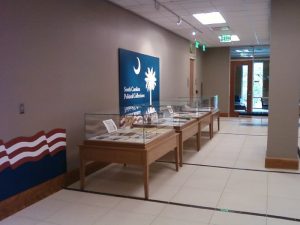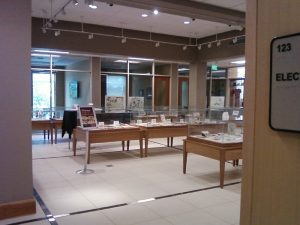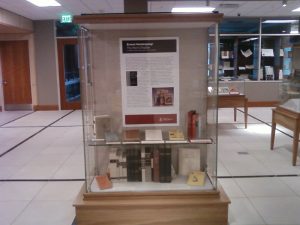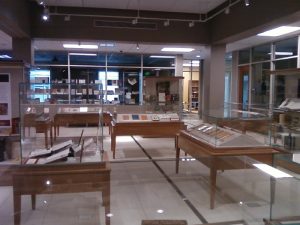This article is more than 5 years old.
Last week I attended the South Carolina Archival Association’s Fall Meeting. The topic was “Thinking Outside the Archival Box: Expanding our Reach to Underserved and Underrepresented Groups” which fit perfectly with the initiative that we here at the WFU Archives are beginning*. The conference was held in the Hollings Special Collections Library at the University of South Carolina. It was built in 2010, connecting to the Thomas Cooper library, the main undergraduate library. It was a great facility for the meeting, with a large conference room at the back and the main collections housed on either side of a large reading room (Rare Books on one side, Political Collections on the other). There are large spaces in front of each collection area that are full of display cases where they show memorabilia, photos and books.


USC just recently acquired over 1200 Hemingway items which they added to their existing materials, making it the most complete collection of his published works. What an incredible collection and exhibit! USC’s Hemingway Collection


Once we were settled in the meeting area, our session began with Christopher Judge, who is the Assistant Director of the Native American Studies department at USC-Lancaster. The program began in 2003 when Dr. Tom Blumer donated his collection of research to the USC-L library. In the collection are his “papers, archives, and artifacts, all dealing with the Catawba Indians. The T.J. Blumer Catawba Research Collection contains a wide variety of materials created and collected by the donor over a 40-year period as he conducted his research on the Catawba and other Native American peoples, with a focus on the pottery of the Catawba Indians. These materials form the single largest documentary collection of materials about the Catawba in existence. The collection also provides the best existing documentation on the life, work, techniques, and products of the Catawba potters, artists who have maintained a continuous tradition stretching back hundreds, if not thousands, of years”. (Native American Studies Program). Building on this core collection, the school developed the Native American Studies department which includes an archaeologist (Judge), a folklorist/oral historian, art instructor/curator of the pottery collection, archivist, and an English instructor/Catawba linguist. They work closely with the Native American people of the area to make sure they are accurately sharing the NA culture and heritage with the students in the program as well as the community.
Brent Burgin, director of the NA archives then told us that there are over 40,000 Native American people currently living in South Carolina, but their history and culture is hardly known at all, and what is known many times is myth. He shared about how he and the other members of the department have worked and continue to work hard to gain the trust of the NA people in the area. He said he felt very awkward and nervous about approaching them to talk about starting other collections for the archives because he didn’t want them to feel patronized. They have such a long history of persecution that he understood why they didn’t trust “outside” people who seem to want to work with them but may have ulterior motives. After he got past his “Amero-centricity” he realized that he needed to just be himself, and show that he is sincere about wanting to document and preserve the NA history with the help of the local tribes. Burgin said that he and all of the faculty have worked to gain the trust of the local people over the years, and they have a strong relationship on both sides now. He stated that identity, accountability and advocacy are the most important things for him and the other faculty to remember as they work with the NA people.
* The archive is “Switzerland” when it comes to political issues of the tribes; they include all information and don’t take sides on issues
*They always get the Catawbas’ approval before making presentations or conducting programs to make sure they are representing the people correctly
*They continue to maintain the trust between the archives and NA people, by sharing the rich history and working with the tribe members to help them with questions or research they may be doing
We then heard from Ed Madden, Henry Fulmer and Jeffery Makala about the LGBTQ and AIDS/HIV Collections at the main campus. Madden, an associate professor of English and the director of undergraduate studies in the Women and Gender studies program, shared about his experiences using LGBTQ collections in his research on gender theory and Irish cultural studies. He discussed how difficult some items were to find, and that being able to study the originals was much preferable to using a digitized version at times. Because of his extensive research over the years, he has become a sort of archivist himself, helping to bring various donations to the LGBTQ collection at the South Caroliniana Library. He noted that very little has been done to intentionally document experiences of LGBTQ people in the US, and that for a long time it was seen unimportant or inappropriate to do so. Thankfully that idea is changing…
Henry Fulmer, curator of manuscripts at the South Caroliniana Library, discussed the GLBTQ collection itself, and how it has evolved over the years. They began the collection in 1970, and it documents the people, events and organizations connected to GLBTQ efforts and activities throughout the state of South Carolina. Jim Blanton, Harriet Hancock, Santi Thompson, Harlan Greene, DiAna DiAna, and Patricia Volker are just a few of the people who have donated their papers to the collection as well as groups such as the AIDS Benefit Council, Alliance for Full Acceptance and the Affirm Organization.
Jeffery Makala then told us about the HIV/AIDS collection, which he has helped to build from scratch. It started by documenting the first 10 years of the AIDS epidemic in America and continued to grow and widen its coverage. Originally focused on South Carolina materials, the collection now includes rare and unique materials from all over. For example, it now houses the only complete run of The Advocate in SC, many originals of a magazine called RFD, APA publications and high school teacher guides. It also includes 1700 monographs, 20-30 runs of different periodicals and a variety of realia such as buttons, ribbons, badges and shirts.
All of these efforts to document groups that have been historically un- or under-represented demonstrate large-scale programs and support of them. It was heartening and encouraging to hear about the development of these collections and to see that there is now a concerted effort to preserve the history of these people. Since ZSR operates on a smaller scale than USC, it might seem that there aren’t a lot of “take-aways” for me from this conference. But truly the bottom line is the same for us as for them as for any institution: you must establish and maintain trust between you and the group that has been unrepresented or ignored. If an archives is making a sincere effort to be inclusive and represent the many groups of its institution or area, the groups in turn should be able see that their collections will be protected and maintained in a place that will represent all of its donors in a professional way. These things can be done in any archives of any size, and I am happy to say that we are launching such an effort here this month. (*See Documenting Diversity for more info on our kickoff )! Learning from other institutions who have already moved ahead with this kind of project is the best way to plan our approach. We can see what has worked well for these groups and incorporate the same type of efforts and activities here, tailored to WFU. We look forward to growing our University Archives with all groups who are part of the school’s history.
4 Comments on ‘Don’t Forget Them: Documenting Underserved and Underrepresented Groups in the Archives’
Excellent report Vicki!
Sounds like a great conference. And the Hemingway collection is cool. Thanks, Vicki!
Thanks for sharing, it appears to have been a worthwhile event!
I love the Native American story. Thanks, Vicki.